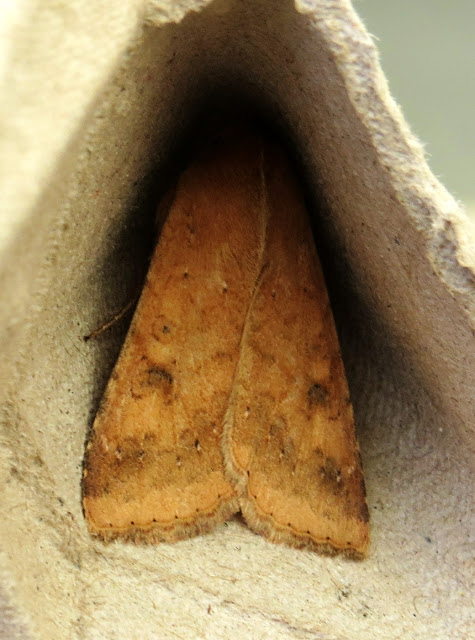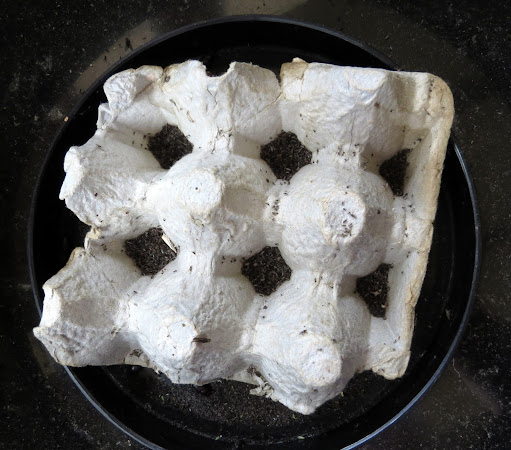Saturday, August 29
The moth traps were species poor this morning, after yet more overnight heavy rain and a strong northerly wind. Over a hundred moths, most of them Large Yellow Underwings (Blunders) and Setaceous Hebrew Character (SHC). The weather must have kept the bats away - we have a bat nursery in the roof space - I'm sure that they feed very well on the big bodied Blunders, which are the plankton for both birds and bats. We have a front garden Robin which arrives when Pam is emptying the eggboxes. She has to be both vigilant and enterprising in her choice of freedom zone.
Whilst checking the areas around the traps, Pam found a small and rather worn moth, which she potted and brought in for me to see and to identify. I recognised immediately that it was a macro, as small as many micros, the first of which we saw at Dungeness Observatory in 2018. Andy W. brought one in to Natural Surroundings a couple of weeks ago. It was a Norfolk tick for us and now, a garden tick, a Beautiful Marbled Eublemma purpurina
| Norfolk status Very rare immigrant. First recorded in Dorset 2001, only identified from a set specimen during an influx of this previously unrecorded species in 2004. Occurring in mainland Europe, the larvae feed on Creeping Thistle, no evidence of breeding in the UK. New for Norfolk in August 2016, trapped at Filby (D. Hipperson, 25/08/16) Five recorded in 2018 - Eccles-on-Sea (N. Bowman, 27/07/18) New for VC28 at Holme Dunes (G. Hibberd, 13/10/18) and two at Heampstead-by-Holt (A. Wallis, 13/10/18, 15/10/18) Lyng (R.Holt, 20/10/18) |
| |||
| Norfolk Moths website | ||||
|
|
||||
|
|
||||
| That's the fourth really good moth this year, how lucky are we? | ||||
A strong north westerly wind at the end of August? No-brainer. Sea-watching time.But where to go? So many people about, and it's a bank holiday weekend. We tried Walcott first. A flooded field between the Seal Sanctuary and Walcott held a large number of seabirds, loafing and preening. No traffic at the time on this single track lane, so we were able to stop and view. A Lesser Black-backed Gull stood in front of a Great Black-backed Gull caught the eye first. It was a good opportunity to compare the two birds.
Beyond the irrigation pipe - not needed to-day - a group of about twenty Sandwich Terns, amongst the Black-headed Gulls, huddled down on the mud, displaying various stages of moult before their long journey south to Africa. A Norfolk ringed Sandwich Tern has previously made its way to Australia. Amazing.
This year's young on the far right in the first photo..
We found room to park along the sea front at Walcott, the weather must have kept the tourists away. The rain eased, I opened the window to scope the distant horizon, seeing a smattering of terns battling north west against the wind. A dark silhouette shot up from the sea, pestering the terns, jinking and diving aggressively on its target bird. A Bonxie, (Great Skua), my first of the year. The sighting coincided with Pam noticing that we were being sand blasted. We could see it being blown along the road - and all over us and the front of the car - inside! I hastily closed the window, checked my optics - and regretted the decision to open the window.
A further scope scan through a wet and sandy closed window was not a triumph of hope over actuality. Time to move on to Winterton.
We needn't have bothered, we saw two terns making a painfully slow progress west, and nothing else.



















































